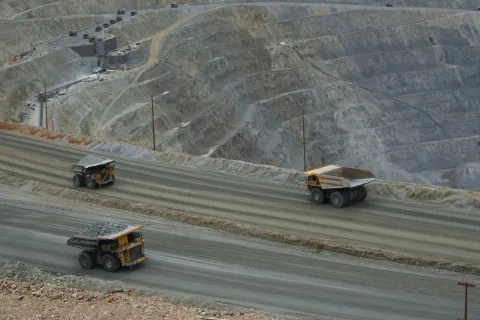Mining industry would boom under a new global carbon tax, research shows

When the mining industry fights carbon taxes, it is arguing against its own economic interests, suggests new research from UBC's Norman B. Keevil Institute of Mining Engineering and School of Public Policy and Global Affairs.
A global carbon tax would bring a financial windfall to the mining industry by forcing a shift in other industries to cleaner technologies that depend on metals and minerals, and any tax on carbon emissions from mining would be small in relation to the value of high-demand commodities generated by the industry.
"The mining industry has a long history of fighting against taxes — all taxes, but especially carbon taxes. We've proven that they're fighting the wrong battles," said Sally Innis, a PhD candidate in mining engineering who co-wrote the study. "The mining industry actually has both a financial and reputational incentive to support harmonized carbon taxation."
Carbon taxation discourages the release of carbon dioxide into the atmosphere by forcing companies to pay for emissions from their activities. The policy is promoted as a way to fight climate change and limit the rise in global mean temperatures to 2°C by 2100, a target set by the 2015 Paris Climate Agreement.
The new study shows two primary reasons why the mining industry's traditional opposition to carbon taxes is misguided:
- Mining is less carbon-intensive than other industries. It emits relatively little carbon dioxide for each dollar of value it produces.
- Demand for mining commodities would skyrocket under a global carbon tax, fuelled by other industries forced to transform in order to survive the tax.
Using data from publicly available sources, the researchers calculated the value of various commodities per tonne of carbon dioxide required to produce them. They found that the high value of metals and minerals from mining makes carbon emissions look small by comparison. That isn't the case for commodities in the energy and agriculture industries.
For example, the analysis showed that $9,400 worth of iron ore can be mined for each tonne of carbon dioxide emitted, but the same emissions yield only $10 worth of coal or $20 worth of cheese.
A carbon tax across industries would therefore have a relatively small impact on mining. Using iron ore as an example, a tax of $150 per tonne would represent less than five per cent of the commodity's value. But for coal, the same tax would represent more than 240 per cent of the commodity's value.
The coal industry would not be able conduct business as usual under those conditions, and neither would many other industries. Their pain would be mining's gain as industries transitioned to cleaner technologies like solar energy.
"Every product that can help us reduce the 36 billion tonnes of carbon dioxide we emit every year involves metals," said PhD student Benjamin Cox, the study's lead author. "To get to zero emissions, we need metals. It would be the largest boom the mining industry has seen since the California Gold Rush of 1849. The demand would be infinite."
The researchers conclude that the mining industry ought to lead the push for a harmonized global carbon tax, because this is one case where sustainability interests align with an industry's economic interests.
"In carbon taxation, we've found an avenue for allyship between the environmentalist movement and the mining industry," said Innis. "We believe it's fundamentally important to find these allyships and partnerships between divergent groups."
The study, "The mining industry as a net beneficiary of a global tax on carbon emissions," was published Thursday by Nature Communications Earth and Environment.
This article originally appeared on UBC News.